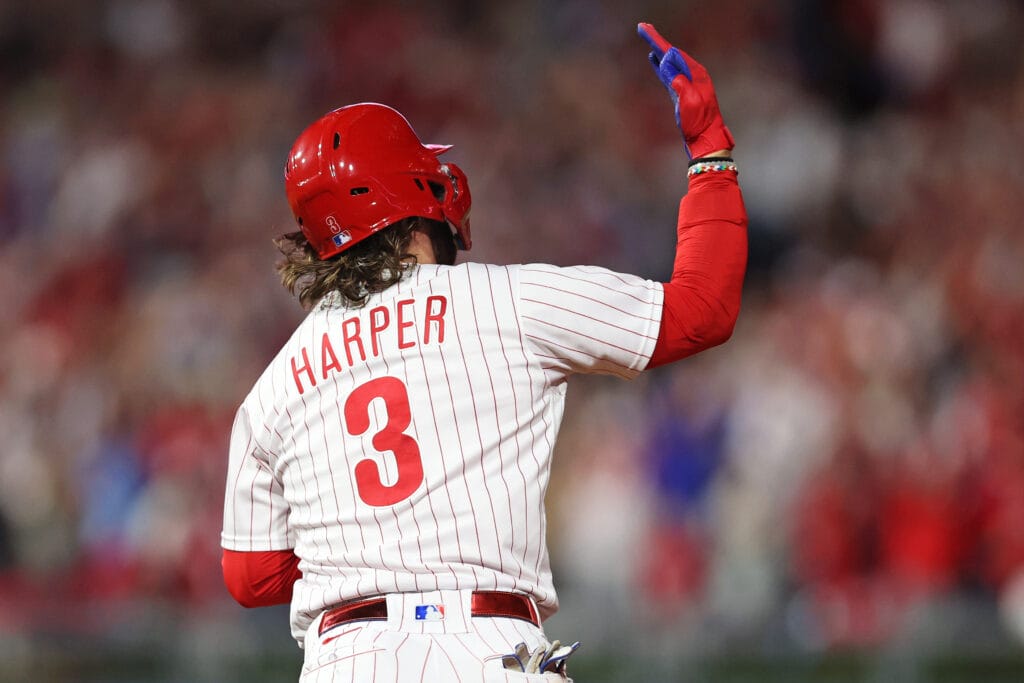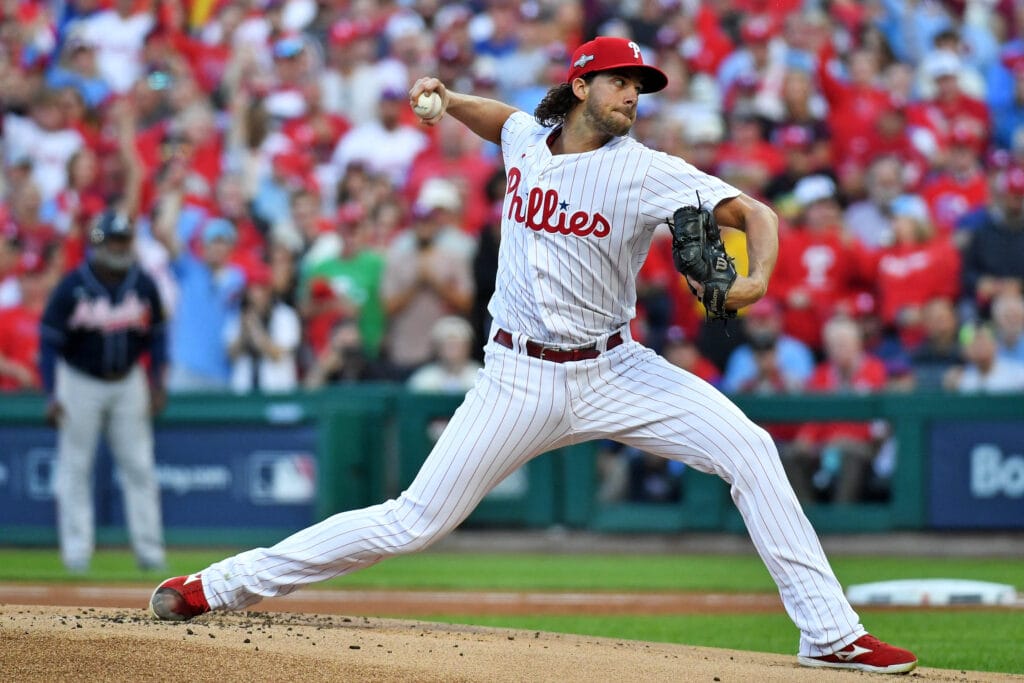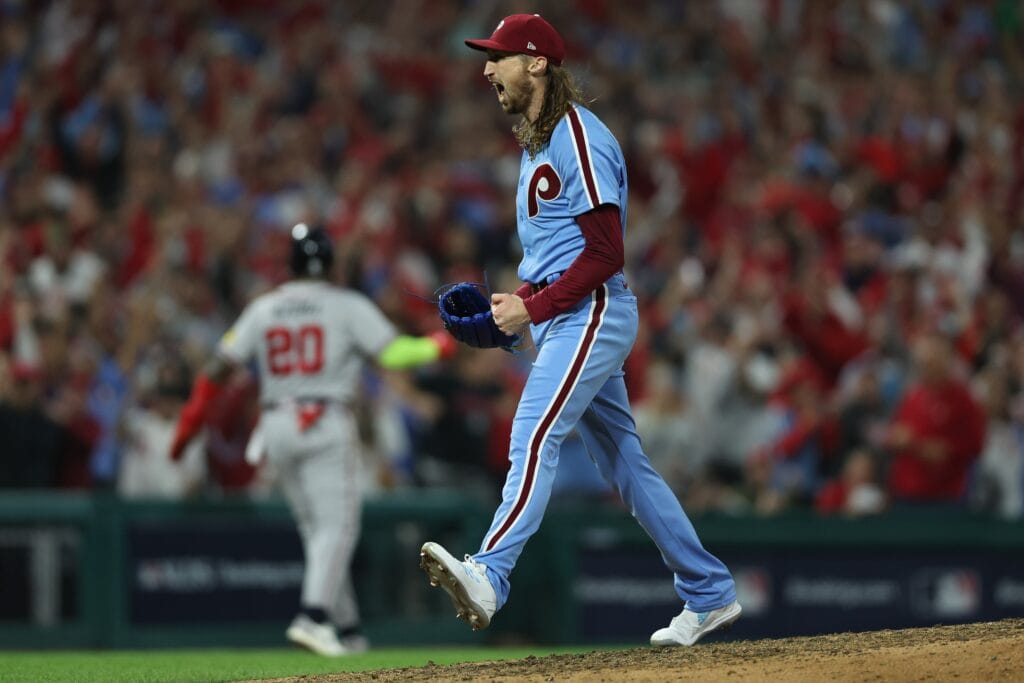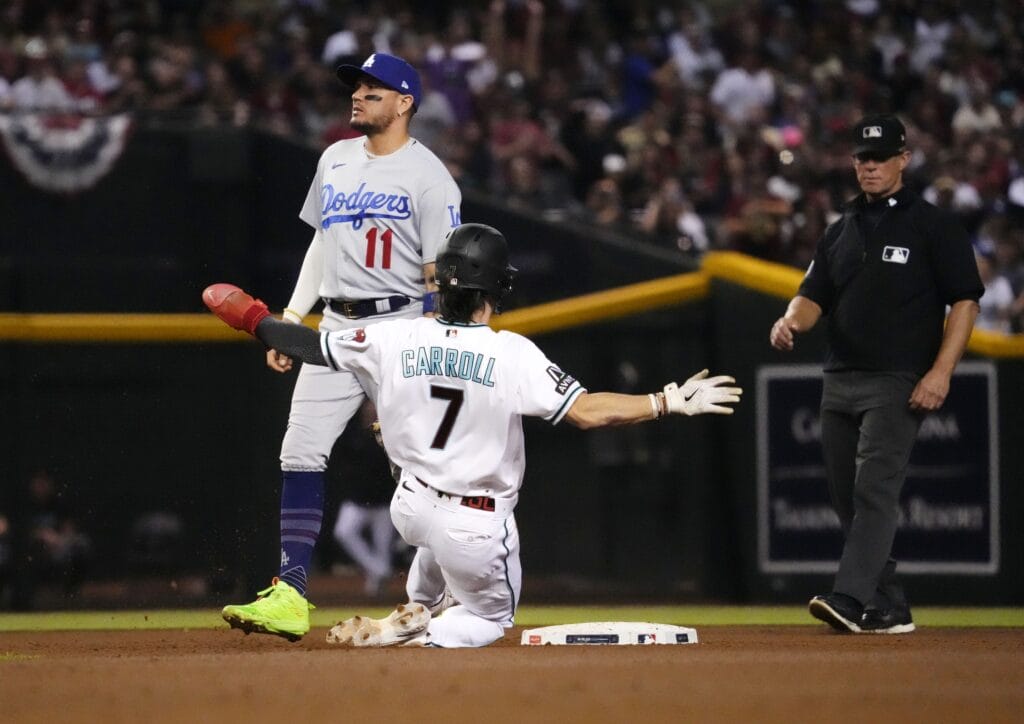© 2025 ALLCITY Network Inc.
All rights reserved.

PHILADELPHIA — When the Diamondbacks opened a three-game set at home against the Philadelphia Phillies on June 12, the Phillies were 32-33. They sat in third place in the NL East and they had been outscored by 33 runs.
Philadelphia’s best hitter, Bryce Harper, had made a remarkably fast return from Tommy John surgery, but he was not hitting for power as he had in the past. Trea Turner, whom the Phillies had just signed to an 11-year, $300 million contract several months prior, had a .687 OPS. Both Zack Wheeler and Aaron Nola, their top two starters, had ERAs north of 4.00.
Call it a hangover from last year’s World Series appearance or just a slow start, but the Phillies were not playing well.
The Diamondbacks, on the other hand, entered the series 40-25 with a run differential of plus-40. They were tied with the Atlanta Braves for the best record in the National League.
This was the second of two regular season series between the Diamondbacks and Phillies. The D-backs took two of three in the first meetup at Citizens Bank Park, but the Phillies countered by taking three of four in this one. Three of the games were determined by one run; the other concluded with then-Diamondbacks infielder Josh Rojas spinning 37 mile-per-hour eephuses in a 15-3 rout by the Phillies.
From the start of that series through the end of the regular season, the two teams diverged. The Phillies went 58-39. The D-backs went 44-53.
Now, they meet again for the first time in four months. This time, the stakes are higher. The National League pennant is on the line.
“The motivation and all that,” Diamondbacks first baseman Christian Walker said, “it’s easy at this point in the year. You’re putting the team first. It’s win at all costs. Your personal numbers are all aside. It doesn’t matter. There’s something special to that.”
Entering the NLCS, there is no question that the Diamondbacks are underdogs, but they do share many of the same strengths as the Phillies. “I think we match up for the most part pretty close to identical,” Diamondbacks starting pitcher Zac Gallen told reporters on Sunday.
Perhaps Gallen is showing his bias there, but it is not all that difficult to see where he is coming from. Both teams have two top starting pitchers. Both teams are red hot offensively. Both teams’ bullpens have been stellar in recent weeks.
Yes, the Diamondbacks are underdogs, but they were also the underdogs when they faced the Milwaukee Brewers and Los Angeles Dodgers in the first two rounds. They swept both of them.
As the NLCS gets under way, here is a look at how the Diamondbacks and Phillies stack up in five major categories: hitting, starting pitching, relief pitching, defense and baserunning.

Hitting: Advantage Phillies
In the regular season, the Phillies scored 50 more runs than the Diamondbacks and posted a 105 wRC+ (100 is league average) compared to the D-backs’ 97. There is little doubt that the Phillies have the better offense.
In the postseason, however, the Diamondbacks have effectively matched them. The Diamondbacks have averaged six runs per game with an .877 team OPS. The Philies have averaged 5.2 runs per game with an .892 team OPS.
Nearly all of the damage for the Phillies has been incurred by one of four hitters: Bryce Harper, Nick Castellanos, J.T. Realmuto and Trea Turner.
That quartet is making a combined $98.7 million this year, and they have earned it so far in the playoffs.
| Player | PA | AVG | OBP | SLG | OPS |
| Trea Turner | 26 | .500 | .538 | .917 | 1.455 |
| Nick Castellanos | 25 | .391 | .440 | 1.000 | 1.440 |
| Bryce Harper | 26 | .368 | .538 | .842 | 1.380 |
| J.T. Realmuto | 25 | .273 | .333 | .636 | .969 |
In addition to those four, Phillies outfielder Brandon Marsh has also performed admirably at the plate, having gone 5-for-14 with a homer, a double and a walk in 15 plate appearances. As a left-handed hitter who has struggled against left-handed pitching, the Phillies generally only use him against righties.
The rest of the Phillies hitters — designated hitter Kyle Schwarber, infielders Bryson Stott and Alec Bohm, and outfielders Johan Rojas and Christian Pache — have struggled in the playoffs, going a combined 15-for-95 (.158 average) with 39 strikeouts.
It would be a mistake to call the bottom half of the Phillies’ lineup a total dead zone, though. All of those hitters graded out around or above league average offensively in the regular season. There are no holes in their lineup.
In similar fashion to the Phillies, the Diamondbacks have also gotten the bulk of their offensive production from four hitters: Corbin Carroll, Gabriel Moreno, Christian Walker and Ketel Marte.
| Player | PA | AVG | OBP | SLG | OPS |
| Corbin Carroll | 23 | .412 | .565 | .824 | 1.389 |
| Gabriel Moreno | 17 | .250 | .294 | .813 | 1.107 |
| Christian Walker | 23 | .294 | .435 | .588 | 1.023 |
| Ketel Marte | 23 | .318 | .348 | .636 | .984 |
These numbers do not quite line up with those of the Phillies’ top four — how could they? — but the bottom half of the Diamondbacks’ order has offered more than that of Philadelphia. Alek Thomas has an .812 OPS in the playoffs so far, Tommy Pham has posted an .803 mark and Geraldo Perdomo, fresh off his first postseason homer in Game 3 against the Dodgers, is sitting at .792.
Although the D-backs have had more positive contributors so far in the playoffs, the Phillies have the better offense of the two teams.
Of course, postseason results depend heavily on which team is hot at the right time, and this D-backs offense is about as hot as it has ever been right now.

Starting pitching: Advantage Phillies
If we strictly compare the Diamondbacks’ top two starters, Zac Gallen and Merrill Kelly, with the Phillies’ top two starters, Zack Wheeler and Aaron Nola, a case could be made for the Diamondbacks.
Of course, it is not quite that simple, but let’s go down that road for a moment. Here is a look at how Gallen and Wheeler stack up:
| Player | W/L | IP | ERA | WHIP | K% | BB% |
| Zac Gallen | 17-9 | 210 | 3.47 | 1.12 | 26.0 | 5.6 |
| Zack Wheeler | 13-6 | 192 | 3.61 | 1.08 | 26.9 | 5.0 |
And here is a look at Kelly versus Nola:
| Player | W/L | IP | ERA | WHIP | K% | BB% |
| Merrill Kelly | 12-8 | 177.2 | 3.29 | 1.12 | 25.9 | 9.6 |
| Aaron Nola | 12-9 | 193.2 | 4.46 | 1.15 | 25.5 | 5.7 |
Gallen and Wheeler had very similar seasons, and both figure to land near the same position NL Cy Young voting. Kelly had a much better ERA than Nola in the regular season this year, but their peripherals were nearly identical, and Nola had an ERA under 3.30 in two of the past three seasons entering this one.
So far this postseason, Wheeler and Nola have a combined 1.75 ERA in four starts, tallying 30 strikeouts compared to just three walks in 25 2/3 innings. Gallen and Kelly have a combined 2.04 ERA in three starts with 13 strikeouts and seven walks in 17 2/3 innings.
It is entirely possible that the Diamondbacks and Phillies will be perfectly evenly matched in Games 1 and 2, but Game 3 and Game 4 look like a different story.
While not official, it is all but certain that lefty Ranger Suarez will start for the Phillies in Game 3. Suarez had a 4.22 ERA in 25 starts in the regular season, and has a 1.04 ERA in two starts (8 2/3 innings) so far in the playoffs. Suarez was excellent in the Phillies’ run to the World Series last year as well, tallying a 1.23 ERA in 14 2/3 innings.
The Diamondbacks will likely turn to rookie Brandon Pfaadt in Game 3. Pfaadt had a 5.72 ERA in the regular season, although he did muster a 4.22 mark from July 22 through the end of the year. In spite of those improvements, Pfaadt has had one good outing and one poor outing so far in the playoffs. On paper, Suarez has the advantage in Game 3.
As far as Game 4 is concerned, neither team’s starter is obvious.
Phillies manager Rob Thomson said that he has “two really good options,” but his plan will depend on his bullpen usage over the first three games. The options he referred to are right-hander Taijuan Walker and lefty Cristopher Sánchez, neither of whom have pitched in the postseason so far.
Given his veteran status, the more likely Game 4 starter of the two seems to be Walker, whose last — and only — postseason appearance came with the Diamondbacks in 2017. Walker went 15-6 this year for the Phillies with a 4.38 ERA.
Sánchez, meanwhile, posted a 3.44 ERA in the regular season in 99 1/3 innings. Given that Walker is a righty and Sánchez is a lefty, it seems possible that Thomson could use both in Game 4.
As for the Diamondbacks, it is unclear what direction they will go in Game 4. Ryne Nelson could be a candidate after starting 25 games in the regular season, but he had an unsightly 5.31 ERA in those games. Nelson did not fare well in his only postseason appearance so far; he faced four batters in Game 1 of the Wild Card Series against the Brewers and gave up singles to three of them.
A bullpen game could also be an option for the Diamondbacks, but that would depend on how much they are forced to tax their relievers in the first four games of the series. Given that those four games happen in a five-day span, there will not be much extra time to rest.
No matter how the Diamondbacks line up their pitchers in Game 4, the simple reality is that the Phillies, on paper, will have an advantage in any game not started by Gallen or Kelly.

Relief Pitching: Advantage Phillies
For as great as this revitalized Diamondbacks bullpen has looked lately, it is difficult to pick any relief pitcher corps in baseball over that of the Phillies right now.
In the regular season, Phillies relievers posted a teamwide 3.58 ERA, which ranked seventh in baseball. In the playoffs, the unit has a 1.45 ERA, the best of any remaining team.
In Gregory Soto, Matt Strahm and José Alvarado, the Phillies have three lefties with excellent stuff. Two of them, Soto and Alvarado, average 99 mph with their respective fastballs. Strahm has excellent life on his four-seamer and one of the best sliders in the game.
The Phillies have a variety of weapons from the right side, too, including longtime MLB closer Craig Kimbrel — yes, he is still good — an emerging rookie with wipeout stuff in Orion Kerkering and a 30-year-old having, by far, the best season of his career in Jeff Hoffman.
The Diamondbacks do not have the quality of raw stuff that the Phillies do, but it is hard to argue with the results they have churned out lately. After posting a 2.16 combined ERA in September, D-backs relievers have amassed a 1.77 mark so far in the playoffs.
Only two Diamondbacks relievers, in fact, have been charged with an earned run so far in the postseason. Miguel Castro gave up two runs in Game 1 against the Dodgers while pitching with a significant lead. Ryan Thompson allowed a pair of runs in Game 3 against the Dodgers, but the D-backs won anyway.
Based on recent performance, these bullpens are comparable. The edge goes to that of the Phillies’, however, because of their regular-season track record and ability to induce whiffs at a high clip.

Defense: Advantage Diamondbacks
In the regular season, the Diamondbacks ranked fourth in the majors with 46 defensive runs saved (DRS) and second with 31 outs above average (OAA). The Phillies ranked 25th with minus-25 DRS and 17th with minus-2 OAA. The D-backs are the better defensive team, full stop.
It should be noted, however, that much of the Phillies’ negative defense value came from Kyle Schwarber, who played in 103 games in left field in the regular season. Schwarber has never had much range in the outfield, but the Phillies had no choice but to play him there when Harper was relegated to DH duty upon returning from Tommy John surgery in May. Schwarber logged minus-21 DRS and minus-19 OAA in 872 1/3 innings of defense over the course of the season, grading out as the worst defender in baseball.
Eventually, Harper built up enough arm strength to play first base, a position he had effectively never played in the majors. He made his first appearance there in late July and enabled Schwarber to move back to DH in the process. Schwarber played outfield only sparingly down the stretch, and he has been used exclusively as a DH in the playoffs.
All that is to say: With Schwarber at DH, as he is being used now, this Phillies defense is not as poor as the metrics indicate. Nonetheless, the D-backs are still the better defensive team.
While Johan Rojas and Bryson Stott are top-notch in center field and second base, respectively, shortstop Trea Turner, third baseman Alec Bohm and right fielder Nick Castellanos all grade out poorly at their respective positions.
The Diamondbacks have an excellent center fielder in Alek Thomas, an elite first baseman in Christian Walker and one of the best defensive catchers in baseball in Gabriel Moreno. Their defenders at all other positions grade out around average or above. Count this as an advantage for the D-backs.

Baserunning: Advantage Diamondbacks
The Diamondbacks are well-established as one of the best baserunning teams in the league — heck, they have Corbin Carroll — but these Phillies can run, too.
The Phillies stole 141 bases in the regular season, which ranked seventh in baseball. They also had the third-best stolen base percentage in the majors at 84.4 percent. They are 9-for-10 in stolen bases so far in the playoffs.
The majority of Philadelphia’s stolen bases come from Stott and Turner, who went 31-for-34 and 30-for-30 in the regular season, respectively. The Phillies also had Realmuto, Marsh, Harper, Castellanos and Rojas in double digits.
For as good as the Phillies are on the bases, the D-backs are better. Arizona ranked second in the league with 166 stolen bases. Their 86.5 stolen base success rate ranked second as well.
Of course, most of the D-backs’ damage on the bases came from Carroll, who went 54-for-59 in steal attempts. Tommy Pham also went 22-for-25 in the regular season in stolen bases, including an 11-for-13 mark after being traded to the D-backs.
Outside of those two, Perdomo and Walker reached double digits in the regular season.
As far as stolen-base prevention is concerned, the D-backs have arguably the best asset in the sport in Gabriel Moreno. He caught a league-leading 48 percent of attempting base stealers in the regular season. Phillies catcher J.T. Realmuto was far behind yet still better than league average in that regard, nailing 22 percent of attempting base stealers.
For Realmuto and the Phillies’ pitching staff, getting better at controlling the run game has been a point of emphasis over the past month.
“It was kind of costing us some games there in September,” Realmuto said, “so finally we paid a little more attention. We made some adjustments. Our pitchers were out there working on it before batting practice, stuff like that.
“Against a team like this in Arizona, obviously that’s going to be really important because they have a lot of guys that can steal bases.”
Of course, baserunning is not as simple as stealing bases and preventing stolen bases. There are other factors, such as avoiding unnecessary outs and taking extra bases on balls in play.
Both teams made the exact same number of outs on the bases in the regular season (47), but the D-backs inched out the Phillies in extra bases taken percentage, finishing the year at 46 percent (fourth in the majors) compared to the Phillies’ 43 percent (league average is 42 percent).
The margin is not especially large here — the Phillies actually have two more steals so far in the playoffs — but the Diamondbacks, on paper, are the better baserunning team.
Follow Jesse Friedman on X (formerly Twitter)
Top photo: Bill Streicher/USA TODAY Sports
Get Arizona's Best Sports Content In Your Inbox!Become a smarter Arizona sports fan with the latest game recaps, analysis and exclusive content from PHNX's writers and podcasters!
Just drop your email below!
Comments
Share your thoughts
Join the conversation



